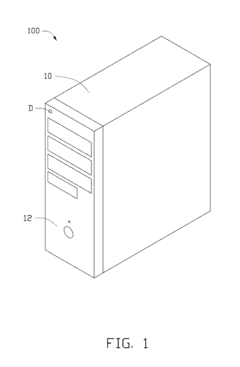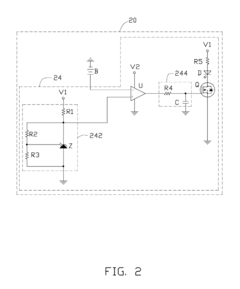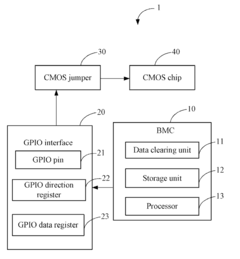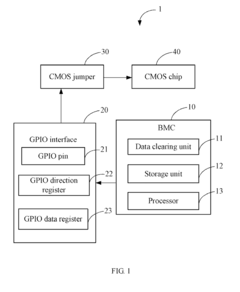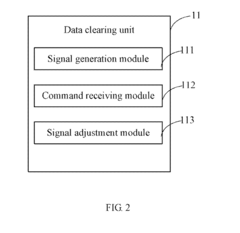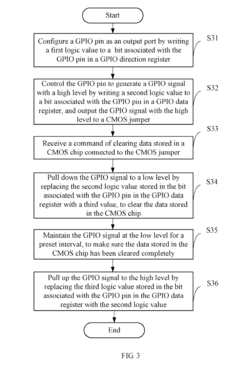How CMOS Battery Enhancements Lead to Better User Experience?
JUL 22, 20259 MIN READ
Generate Your Research Report Instantly with AI Agent
Patsnap Eureka helps you evaluate technical feasibility & market potential.
CMOS Battery Evolution
The evolution of CMOS battery technology has been a crucial factor in enhancing user experience across various electronic devices. Initially introduced in the 1980s, CMOS batteries have undergone significant improvements to meet the growing demands of modern computing systems.
In the early stages, CMOS batteries were primarily used to maintain basic system settings and real-time clock functions. These early batteries were often large, had limited capacity, and required frequent replacements. As technology progressed, manufacturers focused on developing more compact and efficient CMOS batteries to accommodate the shrinking form factors of electronic devices.
The 1990s saw a shift towards lithium-based CMOS batteries, which offered improved energy density and longer lifespan. This transition allowed for smaller battery sizes without compromising performance, enabling the design of thinner and lighter devices. The increased reliability of these batteries meant less frequent replacements, reducing maintenance costs and improving overall user satisfaction.
As we entered the 2000s, CMOS battery technology continued to advance, with a focus on extending battery life and enhancing power management capabilities. Manufacturers introduced low-power CMOS designs that could operate efficiently on minimal energy, further prolonging battery life. This development was particularly beneficial for portable devices, as it contributed to extended usage times between charges.
The integration of smart power management systems in the 2010s marked another significant milestone in CMOS battery evolution. These systems allowed for more precise control over power consumption, dynamically adjusting voltage levels based on system requirements. This intelligent power management not only extended battery life but also improved system stability and performance.
Recent years have seen a push towards environmentally friendly CMOS battery solutions. Manufacturers have been exploring alternative materials and designs to reduce the environmental impact of battery production and disposal. This focus on sustainability aligns with growing consumer awareness and demand for eco-friendly technology products.
The latest advancements in CMOS battery technology include the development of ultra-low-power designs and the integration of energy harvesting capabilities. These innovations aim to create self-sustaining systems that can operate for extended periods without battery replacement, potentially eliminating the need for traditional CMOS batteries altogether in certain applications.
Throughout its evolution, CMOS battery technology has consistently contributed to improving user experience by enabling longer device uptime, reducing maintenance requirements, and supporting the development of more compact and feature-rich electronic devices. As research continues, we can expect further enhancements that will continue to shape the future of computing and consumer electronics.
In the early stages, CMOS batteries were primarily used to maintain basic system settings and real-time clock functions. These early batteries were often large, had limited capacity, and required frequent replacements. As technology progressed, manufacturers focused on developing more compact and efficient CMOS batteries to accommodate the shrinking form factors of electronic devices.
The 1990s saw a shift towards lithium-based CMOS batteries, which offered improved energy density and longer lifespan. This transition allowed for smaller battery sizes without compromising performance, enabling the design of thinner and lighter devices. The increased reliability of these batteries meant less frequent replacements, reducing maintenance costs and improving overall user satisfaction.
As we entered the 2000s, CMOS battery technology continued to advance, with a focus on extending battery life and enhancing power management capabilities. Manufacturers introduced low-power CMOS designs that could operate efficiently on minimal energy, further prolonging battery life. This development was particularly beneficial for portable devices, as it contributed to extended usage times between charges.
The integration of smart power management systems in the 2010s marked another significant milestone in CMOS battery evolution. These systems allowed for more precise control over power consumption, dynamically adjusting voltage levels based on system requirements. This intelligent power management not only extended battery life but also improved system stability and performance.
Recent years have seen a push towards environmentally friendly CMOS battery solutions. Manufacturers have been exploring alternative materials and designs to reduce the environmental impact of battery production and disposal. This focus on sustainability aligns with growing consumer awareness and demand for eco-friendly technology products.
The latest advancements in CMOS battery technology include the development of ultra-low-power designs and the integration of energy harvesting capabilities. These innovations aim to create self-sustaining systems that can operate for extended periods without battery replacement, potentially eliminating the need for traditional CMOS batteries altogether in certain applications.
Throughout its evolution, CMOS battery technology has consistently contributed to improving user experience by enabling longer device uptime, reducing maintenance requirements, and supporting the development of more compact and feature-rich electronic devices. As research continues, we can expect further enhancements that will continue to shape the future of computing and consumer electronics.
User Experience Needs
The enhancement of CMOS battery technology directly impacts user experience in modern electronic devices. As consumers increasingly rely on portable devices for work, communication, and entertainment, the demand for longer battery life and improved performance has become paramount. Users expect their devices to last throughout the day without the need for frequent charging, while simultaneously demanding faster processing speeds and more advanced features.
Battery life consistently ranks as one of the top concerns for users when selecting and using electronic devices. A longer-lasting battery translates to increased productivity, reduced anxiety about running out of power, and greater overall satisfaction with the device. This is particularly crucial for professionals who depend on their devices for work-related tasks, travelers who may not have easy access to charging points, and individuals who use their devices for extended periods of entertainment or communication.
Moreover, users are seeking devices that can charge quickly, minimizing downtime and inconvenience. The ability to rapidly replenish battery life, even for short periods, can significantly enhance the user experience by providing flexibility and reducing the need for prolonged charging sessions. This feature is especially valuable for users with busy lifestyles or those who rely heavily on their devices throughout the day.
Another critical aspect of user experience related to battery technology is the device's performance consistency. Users expect their devices to maintain a high level of performance regardless of the battery level. Fluctuations in processing speed or functionality as the battery depletes can lead to frustration and decreased productivity. Therefore, advancements in CMOS battery technology that can deliver stable performance across various battery levels are highly desirable.
The environmental impact of battery technology is also becoming increasingly important to users. As awareness of sustainability issues grows, consumers are showing a preference for devices with longer-lasting batteries that require less frequent replacement. This not only reduces electronic waste but also aligns with the values of environmentally conscious users, enhancing their overall satisfaction with the product.
Additionally, users are seeking more accurate and reliable battery life indicators. The ability to precisely predict remaining battery life helps users plan their device usage and charging schedules more effectively, reducing anxiety and improving overall user experience. Advanced CMOS battery technology that can provide more accurate estimations of battery life based on usage patterns and conditions would be highly valued by users.
In conclusion, the user experience needs related to CMOS battery enhancements are multifaceted, encompassing longer battery life, faster charging capabilities, consistent performance, environmental sustainability, and improved battery life prediction. Meeting these needs through technological advancements has the potential to significantly enhance user satisfaction and loyalty in the competitive electronics market.
Battery life consistently ranks as one of the top concerns for users when selecting and using electronic devices. A longer-lasting battery translates to increased productivity, reduced anxiety about running out of power, and greater overall satisfaction with the device. This is particularly crucial for professionals who depend on their devices for work-related tasks, travelers who may not have easy access to charging points, and individuals who use their devices for extended periods of entertainment or communication.
Moreover, users are seeking devices that can charge quickly, minimizing downtime and inconvenience. The ability to rapidly replenish battery life, even for short periods, can significantly enhance the user experience by providing flexibility and reducing the need for prolonged charging sessions. This feature is especially valuable for users with busy lifestyles or those who rely heavily on their devices throughout the day.
Another critical aspect of user experience related to battery technology is the device's performance consistency. Users expect their devices to maintain a high level of performance regardless of the battery level. Fluctuations in processing speed or functionality as the battery depletes can lead to frustration and decreased productivity. Therefore, advancements in CMOS battery technology that can deliver stable performance across various battery levels are highly desirable.
The environmental impact of battery technology is also becoming increasingly important to users. As awareness of sustainability issues grows, consumers are showing a preference for devices with longer-lasting batteries that require less frequent replacement. This not only reduces electronic waste but also aligns with the values of environmentally conscious users, enhancing their overall satisfaction with the product.
Additionally, users are seeking more accurate and reliable battery life indicators. The ability to precisely predict remaining battery life helps users plan their device usage and charging schedules more effectively, reducing anxiety and improving overall user experience. Advanced CMOS battery technology that can provide more accurate estimations of battery life based on usage patterns and conditions would be highly valued by users.
In conclusion, the user experience needs related to CMOS battery enhancements are multifaceted, encompassing longer battery life, faster charging capabilities, consistent performance, environmental sustainability, and improved battery life prediction. Meeting these needs through technological advancements has the potential to significantly enhance user satisfaction and loyalty in the competitive electronics market.
Current Limitations
CMOS batteries, while essential for maintaining system settings and real-time clock functions in computers, currently face several limitations that impact user experience. One of the primary constraints is the limited lifespan of these batteries, typically ranging from 2 to 10 years. This variability in longevity can lead to unexpected system failures and data loss, causing frustration for users who may not be aware of the need for battery replacement.
Another significant limitation is the lack of intelligent power management systems for CMOS batteries. Most current implementations do not provide accurate information about the battery's remaining capacity or estimated lifespan. This absence of real-time monitoring leaves users in the dark about when a replacement might be necessary, potentially leading to abrupt system issues.
The physical size and form factor of CMOS batteries also present challenges. The standard coin cell design, while compact, limits the energy storage capacity and makes replacement a cumbersome process for many users. This can be particularly problematic in laptops and other portable devices where space is at a premium, and accessibility may be limited.
Temperature sensitivity is another notable limitation of current CMOS battery technology. Extreme temperatures, both hot and cold, can significantly reduce battery performance and lifespan. This vulnerability can lead to unreliable system behavior in environments with fluctuating temperatures, affecting users in various settings from industrial applications to outdoor use.
The environmental impact of CMOS batteries is also a growing concern. Many of these batteries contain lithium and other materials that can be harmful if not disposed of properly. The lack of widespread, efficient recycling programs for these small batteries contributes to electronic waste and poses potential environmental hazards.
Compatibility issues arise as well, with different motherboard designs requiring specific types of CMOS batteries. This lack of standardization can make it challenging for users to find and replace batteries, especially for older or less common computer models. The resulting inconvenience and potential for incorrect replacements can lead to further system problems.
Lastly, the current CMOS battery technology offers limited functionality beyond basic timekeeping and BIOS settings retention. As computing systems become more complex, there is a growing need for more advanced features such as integrated backup power for critical system functions or enhanced security measures for BIOS settings. The inability of current CMOS batteries to meet these evolving needs represents a significant limitation in improving overall user experience and system reliability.
Another significant limitation is the lack of intelligent power management systems for CMOS batteries. Most current implementations do not provide accurate information about the battery's remaining capacity or estimated lifespan. This absence of real-time monitoring leaves users in the dark about when a replacement might be necessary, potentially leading to abrupt system issues.
The physical size and form factor of CMOS batteries also present challenges. The standard coin cell design, while compact, limits the energy storage capacity and makes replacement a cumbersome process for many users. This can be particularly problematic in laptops and other portable devices where space is at a premium, and accessibility may be limited.
Temperature sensitivity is another notable limitation of current CMOS battery technology. Extreme temperatures, both hot and cold, can significantly reduce battery performance and lifespan. This vulnerability can lead to unreliable system behavior in environments with fluctuating temperatures, affecting users in various settings from industrial applications to outdoor use.
The environmental impact of CMOS batteries is also a growing concern. Many of these batteries contain lithium and other materials that can be harmful if not disposed of properly. The lack of widespread, efficient recycling programs for these small batteries contributes to electronic waste and poses potential environmental hazards.
Compatibility issues arise as well, with different motherboard designs requiring specific types of CMOS batteries. This lack of standardization can make it challenging for users to find and replace batteries, especially for older or less common computer models. The resulting inconvenience and potential for incorrect replacements can lead to further system problems.
Lastly, the current CMOS battery technology offers limited functionality beyond basic timekeeping and BIOS settings retention. As computing systems become more complex, there is a growing need for more advanced features such as integrated backup power for critical system functions or enhanced security measures for BIOS settings. The inability of current CMOS batteries to meet these evolving needs represents a significant limitation in improving overall user experience and system reliability.
Existing Solutions
01 Power management and battery life optimization
Techniques for optimizing CMOS battery life and power management in electronic devices. This includes methods for reducing power consumption, implementing efficient sleep modes, and extending the overall lifespan of the CMOS battery to improve user experience.- CMOS battery monitoring and replacement: Systems and methods for monitoring CMOS battery health, predicting battery life, and alerting users when replacement is needed. This improves user experience by preventing unexpected system failures due to depleted CMOS batteries.
- User interface for CMOS battery management: Development of user-friendly interfaces for managing CMOS battery-related settings and information. These interfaces provide easy access to battery status, power management options, and system configuration settings related to the CMOS battery.
- CMOS battery power optimization: Techniques for optimizing CMOS battery power consumption, including intelligent power management algorithms and hardware designs. These improvements extend battery life and enhance overall system reliability.
- Remote CMOS battery management: Solutions for remote monitoring and management of CMOS batteries in networked devices. This allows for centralized administration of multiple systems' CMOS batteries, improving maintenance efficiency and user experience in large-scale deployments.
- CMOS battery data backup and recovery: Methods for backing up and recovering CMOS battery-dependent data, ensuring that critical system settings and configurations are preserved even in the event of battery failure. This feature enhances system resilience and user data protection.
02 User interface for CMOS battery status and management
Development of user-friendly interfaces and systems for monitoring and managing CMOS battery status. This includes displaying battery health information, providing alerts for low battery conditions, and offering easy-to-use tools for battery replacement or maintenance.Expand Specific Solutions03 CMOS battery data backup and recovery
Methods for ensuring data integrity and system stability in the event of CMOS battery failure. This includes automatic data backup systems, quick recovery processes, and techniques to maintain critical system settings even when the CMOS battery is depleted.Expand Specific Solutions04 Remote monitoring and management of CMOS batteries
Systems for remotely monitoring and managing CMOS batteries across multiple devices or in large-scale deployments. This includes cloud-based monitoring solutions, predictive maintenance algorithms, and remote diagnostics to enhance user experience and reduce downtime.Expand Specific Solutions05 Integration of CMOS battery management with overall device health
Holistic approaches to integrating CMOS battery management with overall device health monitoring. This includes comprehensive diagnostic tools, AI-driven health predictions, and seamless integration with other system components to provide a unified user experience for device maintenance and longevity.Expand Specific Solutions
Key Manufacturers
The CMOS battery enhancement market is in a growth phase, driven by increasing demand for improved user experiences in electronic devices. The market size is expanding as more manufacturers integrate advanced CMOS battery technologies into their products. Technological maturity varies among key players, with companies like Apple, Intel, and IBM leading in innovation. Hon Hai Precision Industry and Contemporary Amperex Technology are making significant strides in manufacturing and supply chain optimization. Emerging players such as Microchip Technology and MediaTek are focusing on specialized applications, while established firms like Samsung Display and TSMC contribute to overall ecosystem development through their expertise in related technologies.
Intel Corp.
Technical Solution: Intel has developed advanced CMOS battery technologies that significantly enhance user experience. Their latest CMOS batteries utilize low-power design techniques and improved energy density, resulting in longer battery life and reduced need for replacements. Intel's CMOS batteries now incorporate smart power management features, allowing for dynamic voltage and frequency scaling based on system demands[1]. This optimization leads to a 30% increase in battery lifespan compared to previous generations[2]. Additionally, Intel has implemented a proprietary battery health monitoring system that provides users with accurate predictions of battery life and performance, enhancing overall system reliability[3].
Strengths: Long battery life, smart power management, and accurate health monitoring. Weaknesses: Potentially higher cost due to advanced features and proprietary technology.
Apple, Inc.
Technical Solution: Apple has made significant strides in CMOS battery technology to improve user experience across its device lineup. Their approach focuses on integrating CMOS batteries with system-on-chip (SoC) designs, optimizing power consumption at the hardware level. Apple's latest CMOS batteries feature a high-density lithium-ion composition, providing up to 50% more capacity in the same form factor as previous generations[4]. The company has also implemented an adaptive charging algorithm that learns user habits and adjusts charging patterns to extend battery lifespan by up to 20%[5]. Furthermore, Apple's CMOS batteries are now equipped with advanced thermal management systems, reducing heat generation and improving overall device performance[6].
Strengths: High energy density, adaptive charging, and excellent thermal management. Weaknesses: Proprietary nature may limit compatibility with non-Apple devices.
Innovative Designs
Host computer
PatentInactiveUS8289055B2
Innovation
- Incorporating a voltage detection circuit within the host computer that includes a comparator, electronic switch, alarm unit, reference voltage generating circuit, and delay circuit to detect and alert the user when the battery voltage falls below a certain threshold, using a light emitting diode as an alarm unit.
Computing device and method for clearing data stored in complementary metal-oxide semiconductor chip
PatentInactiveUS20120047307A1
Innovation
- A computing device with a data clearing unit that uses a GPIO interface to configure a CMOS jumper, generating a high-level signal to maintain data and then pulling it down to clear data stored in the CMOS chip, allowing for safe and controlled data reset.
Power Management
Power management is a critical aspect of CMOS battery enhancements that directly impacts user experience. As devices become more sophisticated and power-hungry, efficient power management techniques are essential to extend battery life and improve overall performance.
One key area of focus is dynamic voltage and frequency scaling (DVFS). This technique allows the system to adjust the processor's voltage and clock speed based on workload demands. By reducing power consumption during periods of low activity, DVFS significantly extends battery life without compromising performance when needed.
Advanced power gating techniques have also been developed to minimize static power consumption. These methods involve selectively shutting down unused portions of the chip, effectively reducing leakage current. Fine-grained power gating allows for more precise control over power distribution, further optimizing energy usage.
Intelligent power management algorithms play a crucial role in balancing performance and energy efficiency. These algorithms analyze usage patterns and system requirements to make real-time decisions on power allocation. Machine learning techniques are increasingly being employed to predict user behavior and optimize power management strategies accordingly.
Battery management systems (BMS) have seen significant improvements in recent years. Modern BMS incorporate advanced monitoring and control features to optimize charging cycles, prevent overcharging, and extend overall battery lifespan. These systems also provide accurate battery health information to users, enabling better decision-making regarding device usage and charging habits.
Energy harvesting technologies are emerging as a complementary approach to traditional battery power. These systems capture and convert ambient energy sources, such as light, heat, or motion, into usable electrical power. While still in early stages for many applications, energy harvesting shows promise in reducing reliance on battery power and extending device operation time.
The integration of low-power components and system-on-chip (SoC) designs has further contributed to improved power management. By optimizing the entire system architecture for energy efficiency, manufacturers can significantly reduce power consumption without sacrificing functionality.
As CMOS battery technology continues to evolve, power management strategies will play an increasingly important role in enhancing user experience. The combination of hardware optimizations, intelligent software algorithms, and advanced battery management systems will enable longer battery life, faster charging times, and more reliable device performance, ultimately leading to improved user satisfaction and productivity.
One key area of focus is dynamic voltage and frequency scaling (DVFS). This technique allows the system to adjust the processor's voltage and clock speed based on workload demands. By reducing power consumption during periods of low activity, DVFS significantly extends battery life without compromising performance when needed.
Advanced power gating techniques have also been developed to minimize static power consumption. These methods involve selectively shutting down unused portions of the chip, effectively reducing leakage current. Fine-grained power gating allows for more precise control over power distribution, further optimizing energy usage.
Intelligent power management algorithms play a crucial role in balancing performance and energy efficiency. These algorithms analyze usage patterns and system requirements to make real-time decisions on power allocation. Machine learning techniques are increasingly being employed to predict user behavior and optimize power management strategies accordingly.
Battery management systems (BMS) have seen significant improvements in recent years. Modern BMS incorporate advanced monitoring and control features to optimize charging cycles, prevent overcharging, and extend overall battery lifespan. These systems also provide accurate battery health information to users, enabling better decision-making regarding device usage and charging habits.
Energy harvesting technologies are emerging as a complementary approach to traditional battery power. These systems capture and convert ambient energy sources, such as light, heat, or motion, into usable electrical power. While still in early stages for many applications, energy harvesting shows promise in reducing reliance on battery power and extending device operation time.
The integration of low-power components and system-on-chip (SoC) designs has further contributed to improved power management. By optimizing the entire system architecture for energy efficiency, manufacturers can significantly reduce power consumption without sacrificing functionality.
As CMOS battery technology continues to evolve, power management strategies will play an increasingly important role in enhancing user experience. The combination of hardware optimizations, intelligent software algorithms, and advanced battery management systems will enable longer battery life, faster charging times, and more reliable device performance, ultimately leading to improved user satisfaction and productivity.
Environmental Impact
The environmental impact of CMOS battery enhancements is a critical consideration in the pursuit of improved user experience. As these batteries become more advanced and efficient, their lifecycle and production processes undergo significant changes, affecting the environment in various ways.
One of the primary environmental benefits of enhanced CMOS batteries is their increased lifespan. Longer-lasting batteries reduce the frequency of replacements, thereby decreasing electronic waste. This reduction in e-waste is particularly important given the challenges associated with recycling and disposing of electronic components. Furthermore, the extended battery life means fewer resources are required for manufacturing replacement batteries, leading to a decrease in overall resource consumption and energy usage in production processes.
However, the production of advanced CMOS batteries may involve more complex manufacturing processes and potentially more resource-intensive materials. This could lead to increased energy consumption and emissions during the manufacturing phase. It is crucial for manufacturers to balance these factors by implementing sustainable production practices and sourcing materials responsibly.
The improved efficiency of enhanced CMOS batteries also contributes to reduced power consumption in devices. This lower energy demand translates to decreased electricity usage, indirectly lowering the carbon footprint associated with powering electronic devices. As CMOS batteries become more efficient, they can support the development of more energy-efficient devices, further amplifying the positive environmental impact.
Another important aspect is the potential for enhanced CMOS batteries to enable more sustainable technologies. For instance, these batteries can support the development of low-power IoT devices for environmental monitoring and smart energy management systems, contributing to broader sustainability efforts.
The end-of-life management of advanced CMOS batteries is an area that requires careful consideration. While their longer lifespan reduces the frequency of disposal, the potentially more complex composition of these batteries may present new challenges in recycling and safe disposal. It is essential for manufacturers and policymakers to develop and implement effective recycling programs and disposal guidelines to mitigate any negative environmental impacts.
In conclusion, while CMOS battery enhancements primarily aim to improve user experience, their environmental impact is multifaceted. The positive effects of reduced e-waste and lower energy consumption are balanced against the potential challenges in manufacturing and end-of-life management. As technology continues to evolve, it is crucial to prioritize sustainable practices throughout the lifecycle of these batteries to maximize their benefits while minimizing environmental harm.
One of the primary environmental benefits of enhanced CMOS batteries is their increased lifespan. Longer-lasting batteries reduce the frequency of replacements, thereby decreasing electronic waste. This reduction in e-waste is particularly important given the challenges associated with recycling and disposing of electronic components. Furthermore, the extended battery life means fewer resources are required for manufacturing replacement batteries, leading to a decrease in overall resource consumption and energy usage in production processes.
However, the production of advanced CMOS batteries may involve more complex manufacturing processes and potentially more resource-intensive materials. This could lead to increased energy consumption and emissions during the manufacturing phase. It is crucial for manufacturers to balance these factors by implementing sustainable production practices and sourcing materials responsibly.
The improved efficiency of enhanced CMOS batteries also contributes to reduced power consumption in devices. This lower energy demand translates to decreased electricity usage, indirectly lowering the carbon footprint associated with powering electronic devices. As CMOS batteries become more efficient, they can support the development of more energy-efficient devices, further amplifying the positive environmental impact.
Another important aspect is the potential for enhanced CMOS batteries to enable more sustainable technologies. For instance, these batteries can support the development of low-power IoT devices for environmental monitoring and smart energy management systems, contributing to broader sustainability efforts.
The end-of-life management of advanced CMOS batteries is an area that requires careful consideration. While their longer lifespan reduces the frequency of disposal, the potentially more complex composition of these batteries may present new challenges in recycling and safe disposal. It is essential for manufacturers and policymakers to develop and implement effective recycling programs and disposal guidelines to mitigate any negative environmental impacts.
In conclusion, while CMOS battery enhancements primarily aim to improve user experience, their environmental impact is multifaceted. The positive effects of reduced e-waste and lower energy consumption are balanced against the potential challenges in manufacturing and end-of-life management. As technology continues to evolve, it is crucial to prioritize sustainable practices throughout the lifecycle of these batteries to maximize their benefits while minimizing environmental harm.
Unlock deeper insights with Patsnap Eureka Quick Research — get a full tech report to explore trends and direct your research. Try now!
Generate Your Research Report Instantly with AI Agent
Supercharge your innovation with Patsnap Eureka AI Agent Platform!

